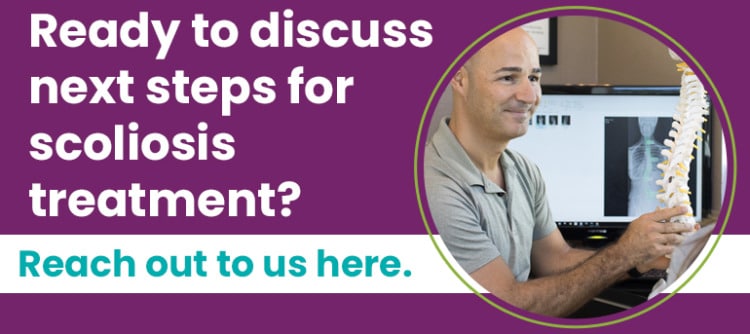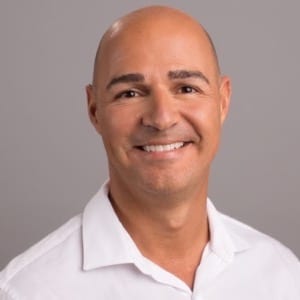When Do You Know Your Child Has Scoliosis? Stages Explained
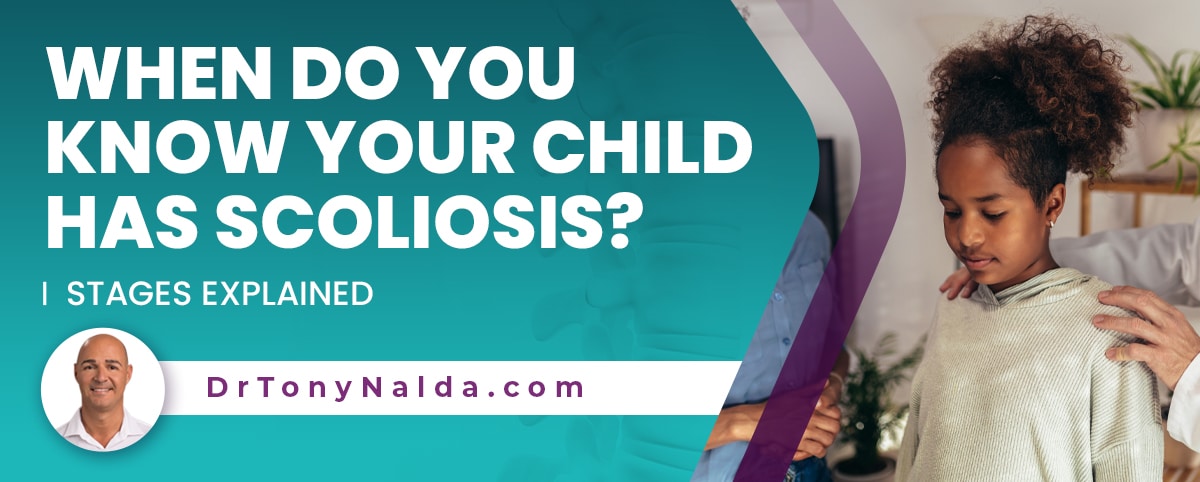
Childhood scoliosis isn't always easy to diagnose. Conditions range in severity, and the signs of mild scoliosis can be subtle, which is why many children aren't diagnosed until conditions have progressed to moderate and/or severe. Early detection is more likely when parents and/or caregivers are aware of the early signs of scoliosis.
As progression is triggered by growth, childhood scoliosis should always be taken seriously. In many cases, children aren't diagnosed when the condition develops, but after it's progressed and become more noticeable. Uneven shoulders and hips are often the earliest signs of scoliosis in children.
Early diagnosis and intervention doesn't guarantee treatment success, but when treatment starts is a factor that shapes how the spine and body will respond.
Table of Contents
Early Signs of Childhood Scoliosis
As the leading spinal condition among school-aged children, scoliosis awareness is important.
Scoliosis affects all ages, but it is most often diagnosed in children.
The different types of childhood scoliosis include congenital scoliosis, infantile scoliosis, early onset juvenile scoliosis, and adolescent idiopathic scoliosis is the most common type overall.
Adolescents are diagnosed between the ages of 10 and reaching skeletal maturity; once skeletal maturity is reached, growth is no longer occurring, and adult scoliosis is diagnosed.
Because the signs and effects of mild scoliosis can be subtle, knowing what to look for is key, so it's beneficial for parents and caregivers to be aware of the condition's prevalence, the early signs of scoliosis, and the benefits of early detection.
Scoliosis Pain
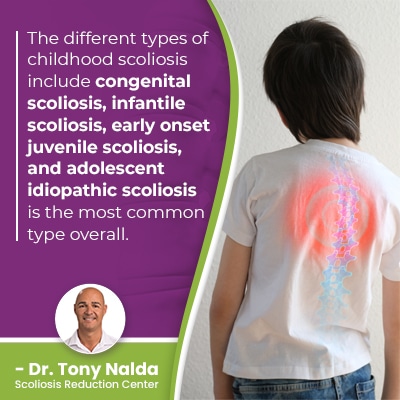 In addition, childhood scoliosis isn't commonly painful because the condition doesn't become compressive until skeletal maturity has been reached, and this is when compression starts to cause back and radiating pain.
In addition, childhood scoliosis isn't commonly painful because the condition doesn't become compressive until skeletal maturity has been reached, and this is when compression starts to cause back and radiating pain.
The constant lengthening motion of growth in the spine counteracts the compressive force of the unnatural spinal curve.
While children can experience varying degrees of muscle pain, when it comes to compressive back pain, this is more closely associated with adult scoliosis, and this is why pain management isn't a common focus of childhood scoliosis treatment, but is a focus when addressing adult scoliosis.
When the spine curves and rotates unnaturally, it needs to be addressed, and this is especially the case with progressive conditions; where a scoliosis is at the time of diagnosis doesn't mean that's where it will stay and that its effects won't change.
As scoliosis causes an unnatural sideways-bending and rotating spinal curvature to develop, a lot of uneven forces are being introduced to the spine, its surrounding muscles and nerves, and the entire body.
While pain is the main symptom of adult scoliosis, postural changes are the main sign of scoliosis in children.
Postural Changes
The main effect of childhood scoliosis involves postural changes caused by the condition's uneven forces disrupting the body's overall symmetry, and in many cases of childhood scoliosis, the earliest changes are uneven shoulders and uneven hips.
One shoulder can sit higher than the other with one shoulder blade protruding more than the other, and one side of the hip can also sit higher than the other; this type of asymmetry can also be easy to conceal, for those wanting to do so.
This is another challenge to early detection of adolescent scoliosis; it's not uncommon for adolescents to be self-conscious about their bodies and conceal asymmetrical changes that are setting them apart from their peers.
Baggy clothes and the fact that adolescents aren't exactly known for good posture can make it even more difficult to spot the condition's early and often subtle postural changes.
Additional Signs of Childhood Scoliosis
As scoliosis progresses, the size of the unnatural spinal curve is increasing, as are the condition's effects, which is why when a child is diagnosed is rarely indicative of when the condition has developed.
Most of my patients are diagnosed with moderate scoliosis because it's when conditions progress from mild to moderate that they start to cause more-noticeable symptoms.
Additional postural changes to watch for in children include:
- The head appearing uncentered over the torso
- An uneven eye line
- Development of a rib cage arch
- Arms and legs that appear to hang at different lengths
If a child's clothing suddenly seems to be ill-fitting with necklines pulling to one side and shirt sleeves and pant legs hanging differently, this is another sign that asymmetrical postural changes are occurring.
Changes to Movement
It's also not just posture that's affected in children with scoliosis, but also movement, and again, the more progression occurs and the more severe a condition, the more noticeable disruptions to movement are going to be.
Disruptions to gait, balance, and coordination are common, and these are also changes that adolescents often try to conceal; this age group doesn't generally want to stand out.
Some children compensate for movement and postural changes, making it difficult for parents and caregivers to notice these types of changes before they are too difficult to conceal.
A common scenario I see is that parents bring their children in for assessment and diagnosis after a family vacation, during which time the asymmetries were noticed because of time spent at the pool or beach in bathing suits.
How to Get a Child Diagnosed
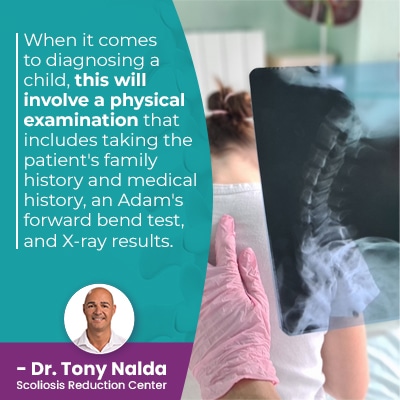 When it comes to diagnosing a child, this will involve a physical examination that includes taking the patient's family history and medical history, an Adam's forward bend test, and X-ray results.
When it comes to diagnosing a child, this will involve a physical examination that includes taking the patient's family history and medical history, an Adam's forward bend test, and X-ray results.
If there is scoliosis in the family, although it's not hereditary, this is considered a risk factor, and this also warrants regular screening as scoliosis is familial.
During an examination, the child will be asked to stand up straight and then bend forward at the hips as if trying to touch the toes, but let the arms dangle loosely at the sides.
In this position, the spine is highly visible, as are any related trunk asymmetries, and if condition indicators are present, this warrants further testing in the form of a scoliosis X-ray.
Scoliosis X-Ray
An X-ray is the only way to reach a diagnosis of scoliosis as the curve's rotational component has to be confirmed, as does the patient's Cobb angle measurement.
A scoliosis curve doesn't just bend unnaturally, it also twists, and a minimum Cobb angle of 10 degrees is needed to be considered a true scoliosis.
Cobb angle is a measurement that indicates how severe conditions are by how unnaturally curved the spine's vertebrae are; the higher the Cobb angle, the more severe a case is, the more complex it is to treat, and the more noticeable its effects are likely to be.
The more growth a child has yet to go through at the time of diagnosis indicates potential progression.
So the only way to definitively know whether or not a child has scoliosis is through professional assessment and the results of a scoliosis X-ray.
Conclusion
When a child is diagnosed with scoliosis, this is difficult news to hear, especially when parents are told it's a progressive condition and treatment is about managing an ongoing condition.
The good news is that scoliosis can be highly treatable, particularly with scoliosis diagnosed early in its progressive line.
The milder scoliosis is, the simpler it is to treat, and there are many benefits to addressing childhood scoliosis with nonsurgical treatment.
The efficacy of non-surgical treatment decreases the more severe cases become: another benefit to starting treatment as soon as possible.
While there are never treatment guarantees, early diagnosis and treatment is associated with treatment success, and knowing the condition's early signs to watch for can result in early detection and the option of starting proactive treatment.
The earliest signs of scoliosis in children are often uneven shoulders and hips, and disruptions to gait and balance are also common.
While having a single postural asymmetry doesn't guarantee a diagnosis of scoliosis, if scoliosis is in the family and postural changes seem to be developing, a screening exam is recommended.
Treatment options for children with scoliosis include spinal fusion surgery or conservative non-surgical treatment.
Progression can increase as a child grows, and if there is a family history of scoliosis, a child's doctor should be conducting regular screening exams from an early age; there are a number of benefits to diagnosing and treating scoliosis prior to a child's first significant pubescent growth spurt.
Here at the Scoliosis Reduction Center®, most children respond well to proactive conservative scoliosis treatment.
A child's spine is flexible and more responsive to treatment, and conservative treatment combines the power of condition-specific chiropractic care, physical therapy, corrective bracing, and rehabilitation.
Dr. Tony Nalda
DOCTOR OF CHIROPRACTIC
After receiving an undergraduate degree in psychology and his Doctorate of Chiropractic from Life University, Dr. Nalda settled in Celebration, Florida and proceeded to build one of Central Florida’s most successful chiropractic clinics.
His experience with patients suffering from scoliosis, and the confusion and frustration they faced, led him to seek a specialty in scoliosis care. In 2006 he completed his Intensive Care Certification from CLEAR Institute, a leading scoliosis educational and certification center.
About Dr. Tony Nalda
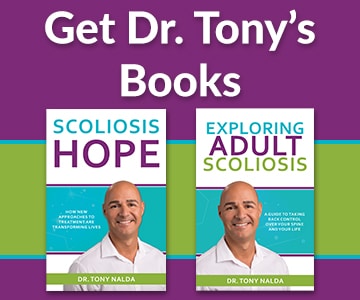 Ready to explore scoliosis treatment? Contact Us Now
Ready to explore scoliosis treatment? Contact Us Now